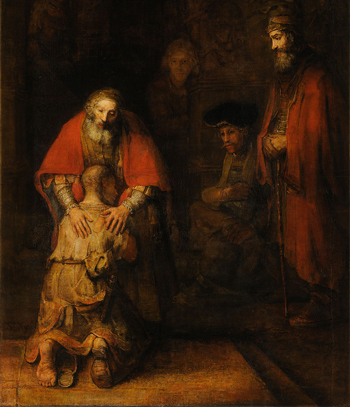
“ Return of The Prodigal Son ” – Rembrandt (1669)
Fourth Sunday in Lent – Luke 15:1-3, 11b-32 March 6
This Sunday is the well known story of the Prodigal Son, only found in Luke’s Gospel. The prodigal son begged for his share of the family inheritance which was granted. He took his fortune to a far away place and quickly spent all he had on his personal pleasures. He was completely broke when a serious famine struck the area and he was forced to tend pigs, an occupation prohibited to Jewish people. As he tended the pigs, he hungered or their scraps and realized that his father’s slaves lived better than he did. It was then that he decided to return home, not as a son, but as a hired hand. So happy was the man’s father when he saw his son return that he celebrated with all sorts of signs of honor. The father’s older son, however, was very displeased with the way his father treated his brother, claiming that he had always been there working like a slave for his father. Never once had the father celebrated with this son. The father explained that the older son had always been with him and obedient. It was cause to rejoice, however, that his other son had been lost but now was found.
There are numerous ways to look at the Prodigal son. Here are 3:
1 The parable is often used to teach the truth that God welcomes the repentant sinner, the outcast. The story of a loving, forgiving, accepting father, illustrates the way God treats those who turn to him for mercy. Jesus critics are illustrated by the behavior of the elder brother, who cannot join in the rejoicing over the lost being found.
2 The story reflects Jesus as much as the son and his teachings of the kingdom. His message was about a God whose love surpasses all typical expressions known to humanity. On the one hand the love is shown celebration after the homecoming of the younger son esus is introducing people to the relational logic of the kingdom of God that runs contrary to and way beyond the legal logic of the world
3. There is a universal message of needing grace since all are foolish in the story . We know the younger son has been foolish, wasting his family’s wealth. The father is also foolish. In response to his son’s remarkably offensive request – asking for an inheritance ahead of time is akin to wishing your parents dead – this father goes ahead and gives it to him. The last scene is with the older son who does not want to accept the younger son. The elder son, too, ends up in a “distant country,” this one of his own making as he loses any connection to his brother, his father, or the others rejoicing in the new life his brother has been given.
Read the full Lectionary Commentary
Rembrandt van Rijn, “The Return of the Prodigal Son,” circa 1668
Rembrandt van Rijn’s The Return of the Prodigal Son is perhaps the most famous and celebrated artwork depicting the parable of the prodigal son, also known as the parable of the forgiving father, from the Gospel of Luke. Created near the end of Rembrandt’s life, the image is one of deep human awareness, mature spirituality, and a quiet invitation to contemplation.
Rembrandt invites us into the parable at the moment when the younger son has just returned home, broken and begging for forgiveness. As his father embraces him, the older brother on the right looks on, while their mother, barely visible, looks on from the top left. Two additional figures, perhaps members of the household, observe the scene.
The most visible faces are those of the father and the older brother, both illuminated and complex in expression. The father’s face is one of mercy: he is overcome with tenderness as he draws his younger son to himself. His face is both paternal and maternal as he harbors, embraces, and comforts the young man. His focus is singular: to love this broken, wounded, and tattered person who has crumbled against him.
The older brother looking on is a tour de force of psychological portraiture. As opposed to the father’s all-out, open, and self-giving embrace, the older brother is an embodiment of closedness and reserve. His hands are clasped in front of him, and he is at a safe distance from the poignant embrace between his father and brother. We expect to see a frown or look of disdain on his face, but instead, the expression of the older son is a face of deep sadness and self-awareness that reveals his gaze as directed more inward than out at the people in front of him. The older brother’s expression shows us the brokenness and repentance that we see depicted in the physical appearance of the younger brother. Both are aware of their brokenness, and this awareness has cast them down to rock bottom. Both will need the healing, forgiving mercy extended to them by the father.
Contemplating Rembrandt’s painting, one has deep compassion for the older brother. He is under the weight of his brokenness yet still stands apart from the loving embrace that would free and heal him. We pray for courage for him and for us too, to step forward into those arms.
Commentary is by Daniella Zsupan-Jerome, assistant professor of liturgy, catechesis, and evangelization at Loyola University New Orleans.
